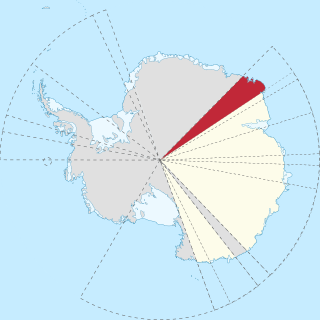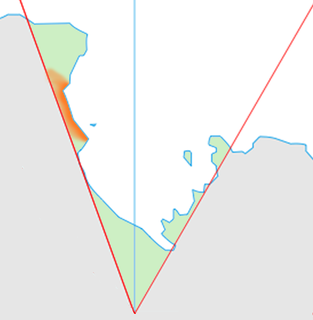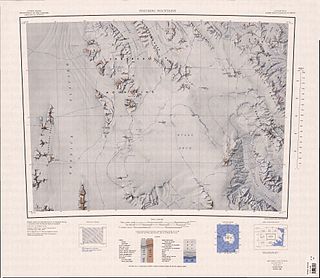
The history of Antarctica emerges from early Western theories of a vast continent, known as Terra Australis, believed to exist in the far south of the globe. The term Antarctic, referring to the opposite of the Arctic Circle, was coined by Marinus of Tyre in the 2nd century AD.

Alexandra Mountains is a group of low, separated mountains in the north portion of Edward VII Peninsula, just southwest of Sulzberger Bay in Marie Byrd Land, Antarctica. Discovered in January–February 1902 by the British National Antarctic Expedition during an exploratory cruise of the Discovery along the Ross Ice Shelf. Named for Alexandra, then Queen of the United Kingdom.

Marie Byrd Land is the portion of West Antarctica lying east of the Ross Ice Shelf and the Ross Sea and south of the Pacific Ocean, extending eastward approximately to a line between the head of the Ross Ice Shelf and Eights Coast. It stretches between 158°W and 103°24'W. The inclusion of the area between the Rockefeller Plateau and Eights Coast is based upon the leading role of the American Rear Admiral Richard E. Byrd in the exploration of this area. The name was originally applied by Admiral Byrd in 1929, in honor of his wife, to the northwestern part of the area, the part that was explored in that year.
The Prince Albert Mountains are a major mountain group in Antarctica over 320 km (200 mi) long. Located in Victoria Land, they run north–south between the Priestley and Ferrar glaciers.

The Usarp Mountains are a major Antarctic mountain range, lying west of the Rennick Glacier and trending north to south for about 190 kilometres (118 mi). The feature is bounded to the north by Pryor Glacier and the Wilson Hills.
George V Coast is that portion of the coast of Antarctica lying between Point Alden, at 148°2′E, and Cape Hudson, at 153°45′E.

Enderby Land is a projecting landmass of Antarctica. Its shore extends from Shinnan Glacier at about 67°55′S44°38′E to William Scoresby Bay at 67°24′S59°34′E, approximately 1⁄24 of the earth's longitude. It was first documented in western and eastern literature in February 1831 by John Biscoe aboard the whaling brig Tula, and named after the Enderby Brothers of London, the ship's owners who encouraged their captains to combine exploration with sealing.
English Coast is that portion of the coast of Antarctica between the northern tip of Rydberg Peninsula and the Buttress Nunataks, on the west side of Palmer Land. To the west is Bryan Coast, and northward runs Rymill Coast east of Alexander Island across George VI Sound. This coast was discovered and explored in 1940, on land by Finn Ronne and Carl R. Eklund and from the air by other members of the East Base of the US Antarctic Service (USAS), 1939–41. It was originally named "Robert English Coast" after Capt. Robert A.J. English, US Navy, Executive Secretary of USAS, 1939–41, and formerly Captain of the Bear of Oakland on the Byrd Antarctic Expedition, 1933–35. The name is shortened for the sake of brevity.

Oates Coast is that portion of the coast of Antarctica between Cape Hudson and Cape Williams. It forms the coast of Oates Land, part of the Australian claim to the Antarctic. The eastern portion of this coast was discovered in February 1911 by Lieutenant Harry Pennell, Royal Navy, commander of the expedition ship Terra Nova during the British Antarctic Expedition, 1910–13. He named the coast after Captain Lawrence E.G. Oates who, with Captain Robert F. Scott and three British Antarctic Expedition companions, perished on the return journey from the South Pole in 1912. Captain Oates' death was described by Robert Falcon Scott as "the act of a brave man and English gentleman". The western portion of the coast, the vicinity of the Mawson Peninsula, was first delineated from air photos taken by U.S. Navy Operation Highjump, 1946–47.
Hanusse Bay is a broad, V-shaped bay, off the west coast of Graham Land, Antarctica. The bay is 37 kilometres (20 nmi) long and trends generally north-south. It is bordered by Cape Mascart on Anvers Island, and Shmidt Point on Arrowsmith Peninsula, Loubet Coast. At its north entrance, Isacke Passage separates it from Liard Island. It is bounded to the south by a line from Landauer Point, the north point of Hansen Island and Bagnold Point on Arrowsmith Peninsula.
Wilson Hills is a group of scattered hills, nunataks and ridges that extend NW-SE for about 110 kilometres (68 mi) between Matusevich Glacier and Pryor Glacier in Antarctica. They were discovered by Lieutenant Harry Pennell, Royal Navy, on the Terra Nova Expedition in February 1911 during Robert Falcon Scott's last expedition, and named after Dr. Edward A. Wilson, a zoologist with the expedition, who perished with Scott on the return journey from the South Pole.

Scott Coast is the portion of the coast of Victoria Land between Cape Washington and Minna Bluff. Named by New Zealand Antarctic Place-Names Committee (NZ-APC) in 1961 after Captain Robert Falcon Scott, Royal Navy, leader of the Discovery expedition (1901–04) and the British Antarctic Expedition (1910-13), who lost his life on the return journey from the South Pole. Much of the early exploration of this coastline was accomplished by Scott and his colleagues, and many of the names in the region were bestowed by him.

Posadowsky Glacier is a glacier about 9 nautical miles long, flowing north to Posadowsky Bay immediately east of Gaussberg. Posadowsky Bay is an open embayment, located just east of the West Ice Shelf and fronting on the Davis Sea in Kaiser Wilhelm II Land. Kaiser Wilhelm II Land is the part of East Antarctica lying between Cape Penck, at 87°43'E, and Cape Filchner, at 91°54'E, and is claimed by Australia as part of the Australian Antarctic Territory. Other notable geographic features in this area include Drygalski Island, located 45 mi NNE of Cape Filchner in the Davis Sea, and Mirny Station, a Russian scientific research station.
Davies Bay is a bay on the coast, 10 nautical miles (19 km) wide, between Drake Head and Cape Kinsey, Antarctica. It was discovered in February 1911 from the Terra Nova of the British Antarctic Expedition, 1910–13, and named for Francis E.C. Davies, shipwright on the Terra Nova.

Evans Névé is a large névé which nourishes Tucker Glacier, Mariner Glacier, Aviator Glacier, Rennick Glacier and Lillie Glacier in Victoria Land, Antarctica. The névé was named in honor for Edgar Evans of the ill-fated British Antarctic Expedition, 1910–13, by the Northern Party of the New Zealand Geological Survey Antarctic Expedition, 1963–64. Evans, along with Edward Adrian Wilson, Lawrence Oates and Henry Robertson Bowers, accompanied Captain Robert F. Scott to the Geographic South Pole, January 17, 1912. All five perished on the return journey after failing to beat Norwegian explorer Roald Amundsen to the 90th parallel. This glaciological feature lies situated on the Pennell Coast, a portion of Antarctica lying between Cape Williams and Cape Adare.

Harald Bay is a bay about 4 nautical miles (7 km) wide indenting the coast between Archer Point and Williamson Head in Oates Land, Antarctica. It contains Kartografov Island. The bay was photographed from the air by U.S. Navy Operation Highjump in 1947. It was sketched and photographed by Phillip Law, leader of the Australian National Antarctic Research Expeditions on February 20, 1959, and was named by the Antarctic Names Committee of Australia for Captain Harald Moller Pederson, master of the Magga Dan during the expedition.
The Terra Nova Islands are a pair of small phantom islands. They were thought to lie off Oates Coast, East Antarctica, about 14 nautical miles (26 km) north of Williamson Head in the Somov Sea.
Laizure Glacier is a broad glacier that enters the sea immediately west of Drake Head, Oates Coast, Antarctica. The glacier was roughly plotted by Australia from U.S. Navy Operation Highjump photography, 1946–47, and from photographs and other data obtained by Australian National Antarctic Research Expeditions, 1959–62. It was mapped in detail by the United States Geological Survey from surveys and U.S. Navy photography, 1960–64, and was named by the Advisory Committee on Antarctic Names for Lieutenant David H. Laizure, U.S. Navy, a navigator on LC-130 aircraft during Operation Deep Freeze 1968.











